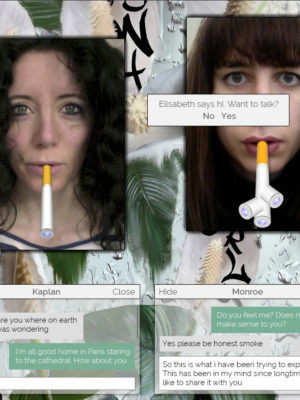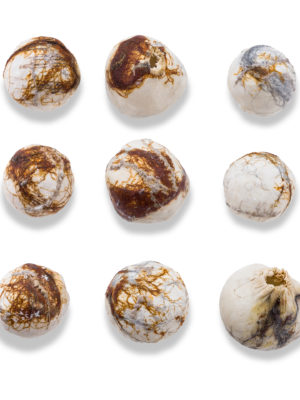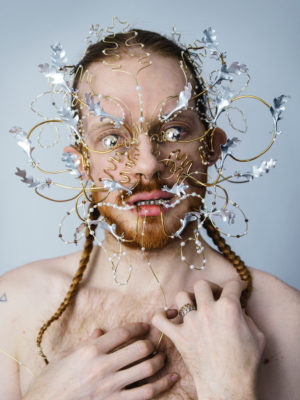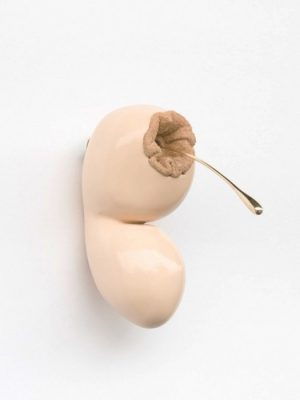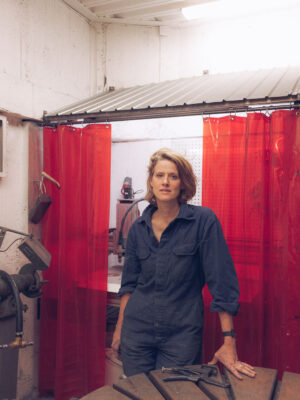Fake = Fearless is a phrase coined by Pinar & Viola during our digital ‘smoking room’ conversation via Skype.
CURRENT OBSESSION
What is your notion of the term fake?
PINAR DEMIRDAG & VIOLA RENATE
V.R. There is a certain freedom to being fake; I think it’s something you can do in an isolated or spontaneous way.
I think about a celebration or something extravagant. It shows a little bit of the game of life, you know? That you don’t always take things seriously: you play. You play with identity, value and representation.
P.D. Obviously fake can have a very negative connotation for so many things. But, I think of fearlessness: of something or someone who is sure about their qualities and viewpoint.
If you can consider yourself strong enough to be purposely associated with fake, it reveals something very strong about your character. At the same time it can be uninteresting. I don’t want to sound like ‘Oh, it’s so fake THUS interesting!’ There are a lot of examples where making things fake is being used as an ironic strategy in art. That is not what I mean; I think it should be deeper than that. Someone who is eager to be fake and really cherish it, someone who isn’t just mocking something that doesn’t belong to him/her… someone who can explore an aspect of life which might be uncomfortably close to his/her own qualities while still being fake — that is interesting.
Do you consider your work fake?
P.D. You know what it is: fantasy.
V.R. It’s not fake!
P.D. It’s fantasy!
What is the difference between fake and fantasy?
P.D. Good question.
V.R. Fake is similar to copying something else, something original.
P.D. Everything fake is a fantasy, actually.
Fantasy originates from something real and develops into something fake?
P.D. The mainstream connotation of fantasy is either very sexual, fairy tale-like or idyllic. Actually, I consider fake a fantasy… a very interesting fantasy.
V.R. Fantasy can be as real as reality: über-über real. Actually a substantial part of our reality is our own fantasy; we create our own reality with our thoughts and personal perceptions.
The general public might see your work as existing on a fantastical plane, due to the overwhelming aesthetics, without immediately making a connection to the real world. Do you think your work uses this style of absurd aesthetics as a way to predict what will happen in the future or as a comment on reality?
P.D. I think we all have our own protection mechanisms to cope with the world. People can either follow the norm and be very comfortable with the way things are or we can decide to create our own ways of dealing with things. For me, our work represents a layer of protection. I’m not trying to say that we are not comfortable with the way things are, I just find it more interesting to be surrounded with the reality we make.
V.R. What we do in our work is not, per se, talking about being fake, but I think we really question what reality is.
We are not interested in sticking to conventional patterns.
This is how we do things: this is how we think we should live – this is how we think we should love. Because of our mode of questioning, we kind of reveal how fake reality is.
P.D. We deal with politicians with sex scandals, how much more real can it be? There is something I would like to highlight in the aesthetics we use: we create stories of how the images of the future would be. If you are familiar with the arc of our work, you will notice that it is slowly shifting. Our subject matter never changes; however, the visuals, the surface, they constantly fluctuate. For a while, I found the Internet aesthetic very interesting, but now it makes me feel saturated to the point of puking. Maybe now I would really just make things even more natural from now on, I don’t know.
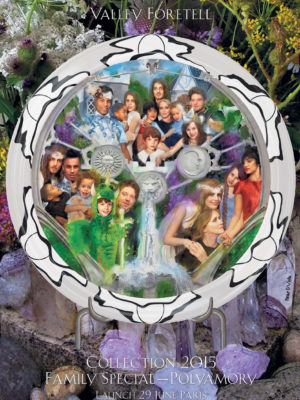
What is the new collection you are launching?
V.R. We really took a step away from the Internet kind of aesthetics and moved towards the existentialist things in our lives. Actually, this collection is about family life. We all have a family life, even if we don’t have a family. It is an image collection depicting the future of the family. It is a hybrid collage, a family constellation constructed to depict how we manage all the challenges in our hectic lives while broadening the horizons of love: coupling, bisexuality, and open relationships. We envision a kind of a modern tribe where this future family exists and children can grow up in a safe and nice environment. The aesthetics here are much more related to natural life… daily life. It is way less digital.
P.D. You will see the influence of Paris in our latest collection. We took a deliberate decision to move to Paris. Our age, our art age or, let’s say, our love age, was 4 years, which is very much of a child. So starting from this year, we would like to change something very fundamental, growing up and becoming mature. With time, I am becoming a woman and I would also like my work to become a woman. That’s why we moved to Paris. This was exactly what we were missing in our work, timeless classics and endurance.
V.R. That’s just more universal and without an expiration date.
Ah, that is why you relate it so much to Paris? Paris never changes in a way: you can go there now or 10 years from now and it remains as extravagant as it is.
V.R. Yes, the fashion is more stable, it’s more classical. Paris is really about refinement and taste and not about big gestures or super experimental trends. But also, literally, our view right now is of the Notre-Dame, it’s built over 700 years ago, took 200 years to build and it will never go out of fashion? It’s such a grandeur and eternal classical beauty.
So, in a way, it is kind of like creating a very stable ground for what Pinar &Viola is?
P.D. Yes, it is like creating a new language, a new visual language.
You started naming your collections ‘surface collections’, but now that you are evolving in this way, will you still use the name ‘surface collections’? And, actually, why ‘surface collections’ to begin with?
P.D. Our studio launches collections founded on portraying the future told in ‘signs’. We want to reveal futuristic scenarios while beautifying our own taboos. So, it is still fundamentally the same collection. We want people to get over their taboos, and we want to depict an idealistic version of what there is to come in a really open way.
V.R. For us, ‘surface collections’ reference totality: the surface, the image, the individual image. The story is always there, of course, but the surface can be anything. Last summer it was a shooting gallery and the surface was denim jeans. It is about communication, about revealing something on a canvas, but you should look at that in a really open way.
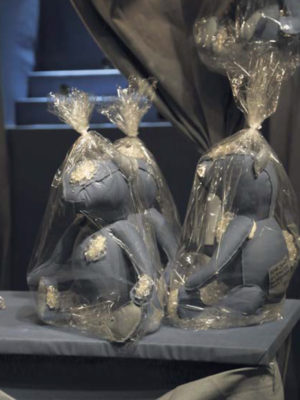
So Pinar & Viola accentuates the medium you choose for each project by adding the word ‘surface’ to the collection?
P.D. I think when you begin your career, you are much more dogmatic; at least, I was. I said I would only make surface collections. I had very specific notions about how to depict reality: things were only interesting when they looked 3-D, fake or flashy. As I began to mature, I realized that life is more fun without dogmas – that ultimately reality is no longer the truth. I am open enough to say that I am very interested in making surface collections, but from now on I don’t want to limit myself to only making surfaces. We make collections: collections of fantasies, sensations about the future, about trends and tendencies that might not exist yet.
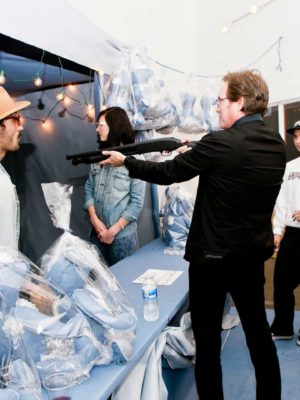
Jewellery has always been seen as either ornament or for the body. On the Pinar & Viola website, you describe one of your projects as: ‘We intend to restore the dignity of ornament and decoration.’ You have also done an album cover for the Dutch electronic band Mass Electric completely designed out of graphics from a phone app. How would you describe the relationship of ornament to your work?
V.R. It changes, but I look at ornamentation as a kind of completion. It is like an expression or gesture to link the different layers of a story together. It carries the content – the message. Ornamentation is really very communicative; you can tell so much with it.
You have also referred to ornament as function. In one of your texts you talk about old books as an example. You point out how they introduce ornamentation and how they work, not only as pure decoration, but also as a way to create an atmosphere integrated with the text. The abundance and function of ornamentation in your work is intriguing, especially in comparison to the lack of tolerance for it in modern jewellery and art.
V.R. Modernism nowadays is an ornament as well. Everything is ornamentation; it is an accentuation of your taste and an expression of who you are and what your work is about.
P.D. When I think of ornamentation I never think of bling or overabundance or decadence. The definition of ornamentation can vary radically but when you think about it, ornamentation is actually our core existence. Any decision we make is an act of ornamentation. Even the books we read are ornamentation for our intellect, right? This idea really empowers me for my work.
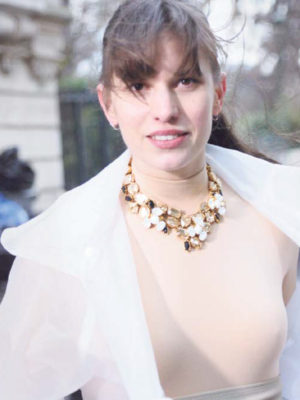
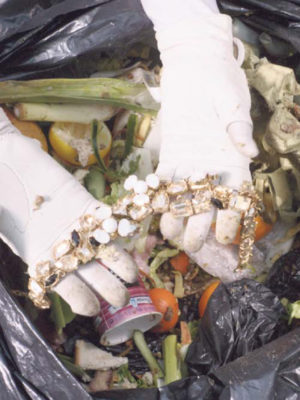
Viola you wear a lot of jewellery, right?
V.R. Actually, now I am very sober. I really like to alternate my body, to temporarily play with my identity. Every piece of jewellery has such a language to it – so many references.
What is so great about jewellery, of course, is the way you curate it is totally authentic. Concerning what I said earlier about the modern look, maybe some day my look will be super modernist, but I would be using that to communicate something else. Ornamentation is transformative. By making the right use of ornaments you can actually make magic with change and communication. That’s also why we are obsessed with surfaces: images, same as ornamentation, are surfaces as well. They reveal or they hide something about the content.
Ornamentation becomes a façade?
V.R. No, that sounds too empty because it can be much more than a façade. The surface reveals the content.
P.D. Ornamentation is not obligated to be only on the surface or a façade. It is a core value, a driving force of why people do the things they do. It is really interesting to see how other cultures deal with ornamentation. In Paris, ornamentation is basically considered a core existentialist value of the French culture. For example, if there is a water leak in your house, instead of repairing it, a very typical response would be to hide it by painting on the wall. While in the Dutch culture, ornamentation is considered almost like a curse word antithetical to their practicality.
What about the selfie phenomena? You have done quite a few projects dealing with it. Do you consider the selfie as decadent and/or a sign that people no longer relate to reality the way they used to? How do you think it came about? What does it represent to you?
P.D. Well, the selfie started with the front camera function introduced by iPhone. The selfie is not an auto-portrait. A selfie, to be more specific, is the photo taken with the front or back camera of your cell phone where you are anywhere. You are everywhere. It gained popularity with the introduction of the flow of images in a newsfeed. Now, instead of reading the news, people look at Facebook or Instagram for news. And if you had a ‘news’ channel where 1000 people were following you, what would be more interesting than your face? I keep seeing people who post pictures of themselves posing in front of the Statue of Liberty calling it a selfie, but that isn’t a true selfie…
V.R. The selfie occurred as a democratisation of the tools we use. Everyone can be famous and customize things. We have become used to the idea that everything revolves around ourselves. The camera just mimics this. The camera literally turned around, turned toward us. We are now the stars of our own realities.
P.D. We once tweeted something really interesting, what
was it Viola?
V.R. About a selfie?
P.D. Yes… something like,‘kids don’t watch TV anymore; they watch themselves’.
V.R. Ah, yes. I also said, ‘just be yourselves because everyone else is already taken’. It’s true. People just want to watch themselves. You want to watch the content created by you.
P.D. The selfie is such a rumour. It starts with “You know what selfie is?” or “Lol These pictures you have been making of yourself do actually have a name”. Because somehow it’s not a complicated word, it’s not like a ‘3d-generated-image’ or a ‘complex hydro electric system’, it’s just a picture of yourself. And then there’s this new word ‘selfie’.
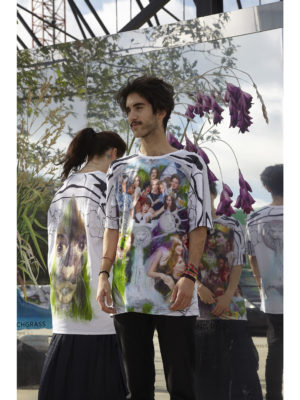
So you think the selfie is not a decadence of social interaction?
P.D. Are you kidding? It’s not true. It’s nothing decadent,
or elite. I mean, Obama makes a selfie, I make a selfie, everyone does… Selfie makes me feel like a one world citizen again, selfie is the democratization of ourselves, of the ‘human Internet kind’ or whatever.
V.R. We all want to re-master our image, right? It is your chance to create your identity, those first few seconds are just so important – that initial scroll down your profile page… There is a whole art of the selfie, like, who’s in the background? What’s your facial expression? Are you alone? With friends? It’s such a composition, such a work in itself! When your friends and your girlfriends look amazing on their profile picture, you also have to keep it up to their level, right?
Like a competition.
More filters…
Fake equals Fear?
V.R. Yeah, kind of and then the photo apps get more advanced…
V.R. More enhancements… you have to keep up!
P.D. When you take a good selfie, it’s like you are achieving something right?
V.R. Yes, of course! It’s like a curation of yourself.
V.R. It’s more like Fake equals Fearlessness.
P.D. Fearless! Not Fake.
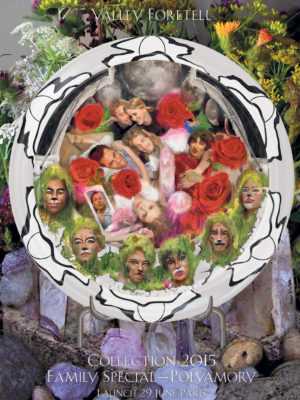
Jing is an artist/designer from Malaysia and is currently based in the Netherlands. A renaissance woman and a seeker of all things fresh and new, follow her on her visual escapades on tumblr at www.bighairybruisedhill.tumblr.com or check out her creations at www.thisisjiiing.com.
This article was first published in
#3 Current Obsession Magazine, 2014
Check out The smoking room here
